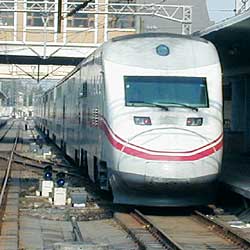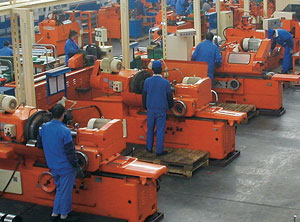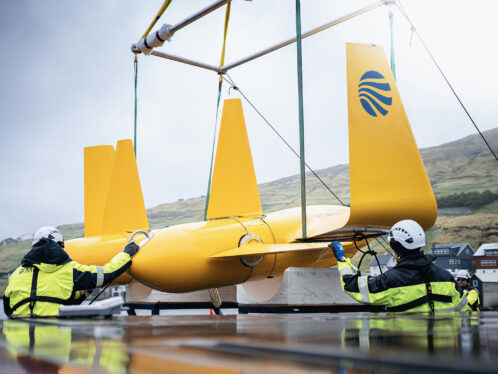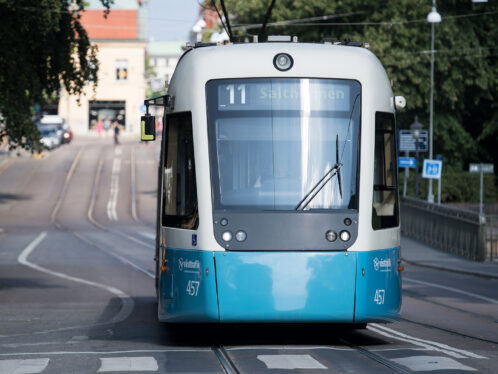
Summary
A win-win partnership
In 1996 SKF and China’s Ministry of Railways established Beijing Nankou SKF Railway Bearings Company Ltd, a joint venture located northwest of Beijing. In five years, the partnership has produced more than 1.2 million tapered bearing units (TBUs). Today SKF is the leading supplier for China’s railway industry. Derwyn Roberts, general manager of SKF Nankou, explains why SKF Nankou is today China’s leading supplier of new TBUs: “With the introduction of SKF design changes, which included a polymer cage, SKF Nankou made a significant contribution to safety on the Chinese railway network. Today there are 660,000 new SKF TBUs in use containing P-cages, and there has not been a single incident or accident caused by cage failure.”
The improved design of SKF Nankou bearings – optimised polymer cages, upgraded micro geometry in their raceways, a new sealing system and high performance grease – also makes them cost-effective. They have a longer running life, lower life-cycle costs and overall higher performance, resulting in better use of the rail network, Roberts says.
Today SKF has five joint-venture manufacturing companies, an investment office and seven sales offices in China, and it may expand its presence even further as market demand for its products grows.
The production output of the SKF Nankou plant has increased 80 percent since its start-up in 1996 and could be increased an additional 40 percent to meet market demand, Roberts says. SKF Nankou will continue to focus on the quality of its products and service. “China is an important market to SKF,” says Roberts.
China’s rail system is undergoing a massive overhaul – with ambitious new rail lines and new and upgraded technology to lower costs and improve safety.At 4,000 metres above sea level, where below-freezing temperatures result in permanently frozen earth, China’s Ministry of Railways is undertaking one of its most ambitious and long-anticipated projects: construction of the Qinghai-Tibet Railway. In June 2001, the ministry began work on the line, which has been under development for more than 50 years. When completed it will run for some 2,000 kilometres along the “roof of the world,” from Golmud, in northwestern China’s Qinghai Province, to the Tibetan capital of Lhasa. The project is indicative of the massive and rapid development of China’s rail system in the past 20 years, since the country began implementing reform policies.
Despite competition from air and road transport, railways continue to dominate freight business in China. Nearly 55 percent of freight is carried by rail, and railroads account for more than 35 percent of passenger transportation. As Chen Boshi, director of the Ministry of Railways’ Freight Car Division, explains: “China is a large country with land accounting for the majority of total area, making railway transportation an imperative. As a developing country, China has yet to establish a full-fledged and advanced freeway and air-freight transport network such as those in the United States and Europe. Therefore, railway transport, which is cost-effective and wide-ranging, will be a common means of transport for a long time to come.”
Huge volume
Spurred on by the growth of the national economy, which has expanded by more than 7 percent for the past several years, China’s rail network is fast becoming one of the largest in the world. In 2001, Chinese railways registered a transportation volume of 1,168 million passengers, and the volume of freight carried by the country’s 440,000 wagons increased to a record-high 1,785 million tonnes. At the end of 2000, 68,000 kilometres of tracks were in operation, among which 21,400 kilometres were double-tracked and 14,900 kilometres were electrified. Approximately 6,000 kilometres of track have been laid in the past five years, reflecting the Ministry of Railways’ determination to overhaul and modernise the country’s rail system.
“The central government has invested a lot in the railway system and made it a priority for the past 10 years, and it will continue to do so for the next five years,” says Jianwei Zhang, vice president of rail transportation for equipment supplier Bombardier’s China operations. During the Ninth Five-Year Plan period (1996–2000) alone, the Ministry of Railways’ investment in the sector exceeded 243,900 million yuan, more than doubling its investment from the previous five-year period.
In addition, China has made remarkable upgrades in reliability and quality, due largely to the infrastructure that has been established and the commitment of the central government. According to Chen from the Ministry of Railways, in the past five years Chinese railways have been improved to carry heavier loads and operate at faster speeds more safely. As Bombardier’s Zhang says, “Not only has the government increased its investment in the industry, it has also increased the quality of rolling stock. Quality has increased very, very rapidly in China in terms of reliability and safety.”
Speed improvement
China’s passenger trains in particular have become faster. Top speeds have been raised to 160 kilometres per hour for some high-speed trains. The past two years have seen four consecutive speed increases and now more than 13,000 kilometres of track run at higher speeds.
Faster trains are attracting more business, particularly in the passenger segment. But, says Chen, the freight business, which plays a major role in the delivery of industrial materials in China, is falling behind. “A plan for speeding up freight trains has yet to be designed,” he says.
When freight trains, which typically run at 80 kilometres per hour, lag behind passenger trains in speed, efficiency is compromised, since the trains share the same rail network.
Applying new technology and updated equipment is one way the ministry intends to address this growing concern. To that end, the ministry has introduced better rolling equipment that is capable of safely handling higher speeds and heavier loads, says Chen. The majority of heavy-duty freight cars are now capable of carrying 21 tonnes in axle weight, with some able to support upwards of 25 tonnes.
Safety first
The introduction of better-quality equipment has drastically improved safety, a top priority for the Ministry. Modernisation in the past five years has resulted in a reduction of the number of accidents caused by component failures. “The overall safety of China’s rail network has been strengthened, resulting in a drop in the incidence rate of accidents and no major accidents caused by faulty rolling stock reported in 2001,” Chen says. Improvements in safety have enhanced reliability as well, which has helped transform the industry into a profit-earning business. A campaign aimed at increasing profitability, combined with improvements in safety and reliability, helped the sector register a targeted profit of 500 million yuan in 2000. From 1994 to 1997 the railways had been operating at a loss.
Transportation sectors around the world have been struggling with low returns for the past several years, but China’s railways seem to be right on track. The central government’s goals for the Tenth Five-Year Plan period (2001–2005) include total operation of 75,000 kilometres of track, with an emphasis on upgrading its existing eight longitudinal and eight lateral lines and improving the overall use, efficiency and safety of the railway network. As China continues its rapid economic development and expands its transportation infrastructure, demand for upgraded technology and equipment is likely to fuel even greater improvements in the country’s railway network.
Grace Wong
a journalist based in Beijing
photos SKF






